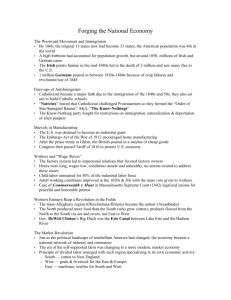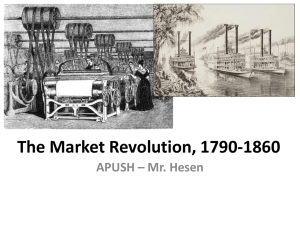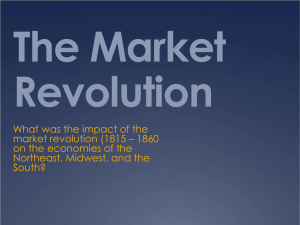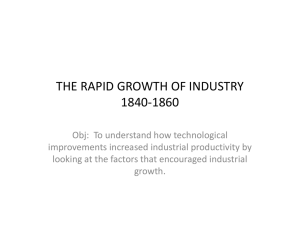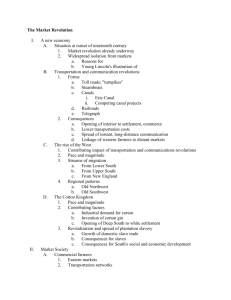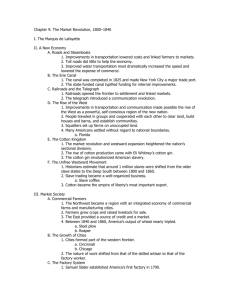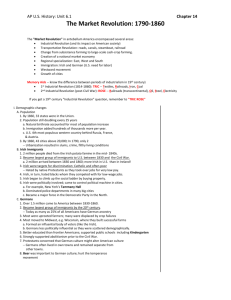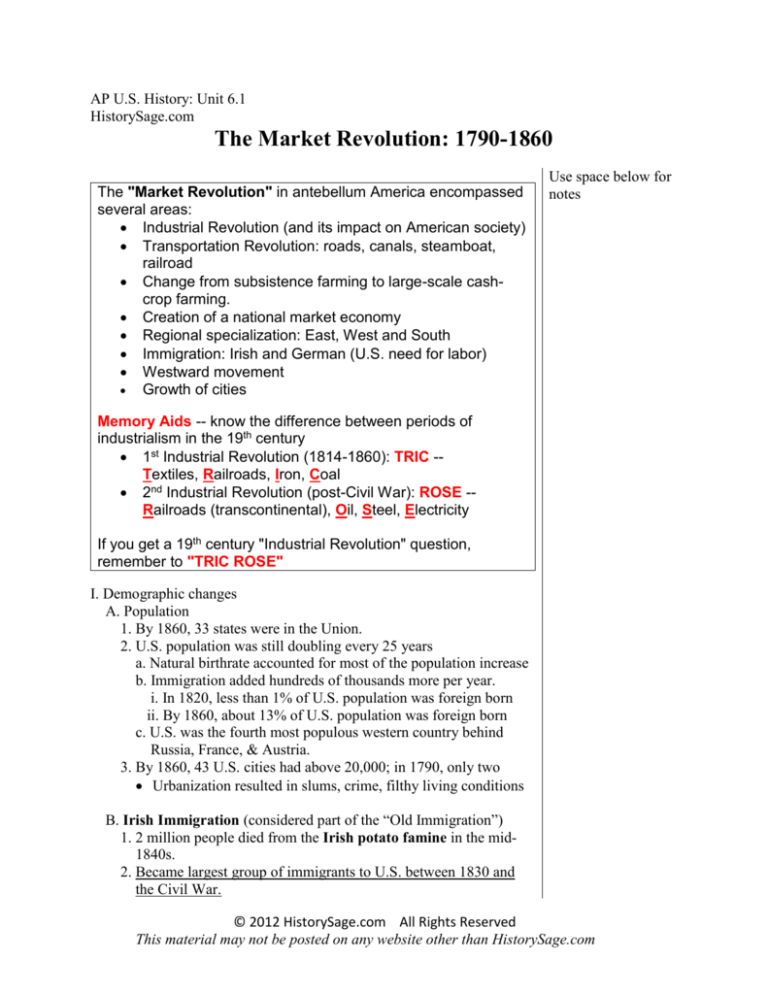
AP U.S. History: Unit 6.1
HistorySage.com
The Market Revolution: 1790-1860
The "Market Revolution" in antebellum America encompassed
several areas:
Industrial Revolution (and its impact on American society)
Transportation Revolution: roads, canals, steamboat,
railroad
Change from subsistence farming to large-scale cashcrop farming.
Creation of a national market economy
Regional specialization: East, West and South
Immigration: Irish and German (U.S. need for labor)
Westward movement
Growth of cities
Use space below for
notes
Memory Aids -- know the difference between periods of
industrialism in the 19th century
1st Industrial Revolution (1814-1860): TRIC -Textiles, Railroads, Iron, Coal
2nd Industrial Revolution (post-Civil War): ROSE -Railroads (transcontinental), Oil, Steel, Electricity
If you get a 19th century "Industrial Revolution" question,
remember to "TRIC ROSE"
I. Demographic changes
A. Population
1. By 1860, 33 states were in the Union.
2. U.S. population was still doubling every 25 years
a. Natural birthrate accounted for most of the population increase
b. Immigration added hundreds of thousands more per year.
i. In 1820, less than 1% of U.S. population was foreign born
ii. By 1860, about 13% of U.S. population was foreign born
c. U.S. was the fourth most populous western country behind
Russia, France, & Austria.
3. By 1860, 43 U.S. cities had above 20,000; in 1790, only two
Urbanization resulted in slums, crime, filthy living conditions
B. Irish Immigration (considered part of the “Old Immigration”)
1. 2 million people died from the Irish potato famine in the mid1840s.
2. Became largest group of immigrants to U.S. between 1830 and
the Civil War.
© 2012 HistorySage.com All Rights Reserved
This material may not be posted on any website other than HistorySage.com
HistorySage.com APUSH Lecture Notes
Unit 6.1:Market Revolution
a. 2 million arrived between 1830 and 1860; more Irish in U.S.
than in Ireland!
b. Came to larger cities: couldn't afford to move out west
Boston and New York (contained more Irish than anywhere
else in the world)
3. Irish were targets for discrimination as they were Catholic and
often poor
They were often hated by native Protestants as the Irish took
over jobs for very low wages.
4. The Irish, in turn, hated blacks whom they competed with for lowwage jobs.
a. Race riots between black & Irish dock workers occurred in
certain port cities.
b. Irish did not support abolitionism.
5. Irish began to climb up the social ladder by buying property.
Rather than going to school, children often worked to help
family buy a home.
6. Irish were politically involved; came to control political machines
in cities.
a. New York City’s Tammany Hall dominated NY politics
b. Machines dominated police departments in many big cities
c. Politicians courted the Irish vote by criticizing Britain, whom
the Irish hated.
d. The Irish became a major force in the Democratic Party in the
North.
C. German immigration (part of the “Old Immigration”)
1. Over 1.5 million came to America between 1830-1860.
2. Became largest group of immigrants by the 20th century.
Today as many as 25% of all Americans have German ancestry
3. Most were uprooted farmers; many were displaced by crop
failures
4. Most moved to Midwest, e.g. Wisconsin, where they built
successful farms
a. Formed an influential body of voters (like the Irish).
b. Germans less politically influential as they were scattered
demographically.
5. Better educated than frontier Americans; supported public schools
including Kindergarten (“children's garden”).
6. Strongly supported abolitionism prior to the Civil War.
7. Protestants concerned that German culture might alter American
culture
Germans often lived in own towns and remained separate from
other towns.
8. Beer was important to German culture; hurt the temperance
movement
© 2012 HistorySage.com All Rights Reserved
Page 2
Use space below for
notes:
HistorySage.com APUSH Lecture Notes
Unit 6.1:Market Revolution
D. English immigration (continuation of the “Old Immigration”)
1. After 1820 thousands of English immigrants arrived; accounted
for almost 20% of total immigrants between 1820-1860
2. Many were leaving tough agricultural conditions behind
Like many German immigrants, many English immigrants
remained in agriculture
3. Those with skills in textiles tended to settle in Massachusetts
4. Miners from the Cornwall region of England came to work in
mining areas in Illinois, Wisconsin, and Michigan
5. English immigrants tended to face far less discrimination than
Irish and German immigrants.
E. Nativism: hatred of foreigners
1. Irish and German immigration offended many Protestant nativists
a. Nativists feared immigrants would overpopulate and unduly
influence politics.
b. Irish and a large minority of Germans were Catholic; viewed as
"foreign" church controlled by the Pope.
2. Catholics constructed a separate parochial educational system.
3. By 1850, Catholics became the largest religious group in
America; outnumbered Baptists, Methodists, Presbyterians, and
Congregationalists.
4. In 1849, extreme American nativists formed the "KnowNothing" party
a. Sought restrictions on immigration and naturalization and
wanted laws to deport poor aliens.
b. Episodes of mass violence occurred in some larger cities.
c. The "Know-Nothings" became extremely influential in the
early-mid 1850s; were on the verge of being the 2nd major party
III. The Industrial Revolution
A. Economic Inventions stimulated economic growth
1. Samuel Slater "Father of the Factory System"
a. 1791, built first efficient cotton-spinning machine in America-utilized the spinning jenny.
b. Pawtucket Mill in Rhode Island was the first textile mill in U.S.
c. However, in America much cloth was still produced by
contractors or women at home.
2. Eli Whitney
a. Cotton gin, 1793: 50x more effective than picking
cotton by hand.
Before, handpicking 1 lb of cotton took a slave an entire day
Cotton production became highly profitable; "King Cotton"
emerged in the South
Slavery, which had been dying out, saw a dramatic increase
Westward expansion into Alabama & Mississippi occurred
© 2012 HistorySage.com All Rights Reserved
Page 3
Use space below for
notes:
HistorySage.com APUSH Lecture Notes
Unit 6.1:Market Revolution
due to increased demand for land.
Stimulated U.S. Industrial Revolution by supplying cotton
to New England textile mills (before, most U.S. cotton was
exported to English textile factories).
b. 1798, introduced principle of interchangeable parts
Basis of modern mass-production, assembly line methods.
Mass-produced muskets for the U.S. Army
3. Sewing Machine
a. Invented by Elias Howe in 1846
b. Isaac Singer developed the machine further
c. Significance: Manufacturing of clothing went from the home to
the factory.
4. Telegraph -- Samuel F. B. Morse
a. 1844, Morse built a 40-mile line from Washington, DC to
Baltimore
b. U.S. gov't didn't control the telegraph; felt it would not pay!
c. Eventually provided instant communication across large
distances.
Significantly influenced business in the following decades
5. Charles Goodyear: vulcanization of rubber created a new
industry.
6. 28,000 patents given in 1850s compared to 306 in 1790s.
B. Textile Industry sparked Industrial Revolution in the U.S. (during
War of 1812)
1. President Jefferson’s Embargo Act (1807) and subsequent War of
1812 (1812-1815) dramatically decreased U.S. imports
2. 1814, Francis Cabot Lowell built first dual-purpose textile plant
at Waltham, Mass.
a. Before Lowell, factories mostly spun thread
b. Lowell's factory spun the fiber and wove the finished cloth.
Also included bleaching, dying, and printing cloth.
3. Significance: Change from manufacturing at home to factories.
4. In 1823, Lowell’s partners, the Boston Associates, built a new
plant at Lowell, Massachusetts
a. Textile factories sprang up all over New England and midAtlantic states in 1830's and 40's.
b. Eventually, Boston Associates dominated textile, railroad,
insurance, and banking businesses throughout Massachusetts.
5. Lowell Girls: Local farmers' daughters hired to work in the
factories
a. Provided the lure of more independence for young women.
b. Lowell promised strict moral supervision and mandatory
church attendance.
c. In 1836, organized one of the first strikes in U.S. history
© 2012 HistorySage.com All Rights Reserved
Page 4
Use space below for
notes
HistorySage.com APUSH Lecture Notes
Unit 6.1:Market Revolution
6. Water power and steam power gradually replaced female labor.
7. Irish and German immigrants replaced Lowell Girls; worked for
very low wages
C. Why did New England become center of the Industrial Revolution?
1. Rocky soil discouraged cash-crop farming; manufacturing more
attractive.
2. Large amount of labor available
3. Shipping brought in capital while seaports made easy imports and
exports.
4. Rapid rivers provided water power.
D. Why didn’t the South industrialize?
1. Capital resources tied up in slaves.
2. Local consumers mostly poor, could not afford most finished
products
E. By 1850, industrial output exceeded agricultural output
1. Embargo Act of 1807, non-intercourse, and War of 1812 meant
Americans had to produce their own goods.
2. European goods again flooded U.S. market after Treaty of Ghent
in 1815.
U.S. factories were crippled by British goods that were sold at
ruinously low prices.
3. Tariffs of 1816, 1828, & 1832 provided some relief to northern
manufacturers.
F. Advances in business organization
1. Limited liability
a. Permitted individual investors, in cases of legal claims or
bankruptcy, to protect their own assets, separate from the
company.
b. Result: More people willing to risk capital = capital
accumulated more rapidly
2. General incorporation laws: first passed in NY in 1848.
a. Businesspeople no longer needed to apply for charters from
state legislature
b. Creating a corporation became much easier.
c. "Free incorporation" statutes widely adopted in other states;
(very Jacksonian in character)
3. Charles River Bridge decision (Charles River Bridge v. Warren
Bridge, 1837)
a. Chief Justice Roger B. Taney: The Constitution reserved to the
states "power over their own improvement, which is so
necessary to their well-being and prosperity."
b. Significance: Encouraged economic development in
© 2012 HistorySage.com All Rights Reserved
Page 5
Use space below for
notes:
HistorySage.com APUSH Lecture Notes
Unit 6.1:Market Revolution
transportation and other public facilities by ending monopolies.
IV. Northern Workers
A. Industrial Revolution transformed manufacturing working
conditions.
1. Skilled workers, craftspeople, were displaced by factory work.
2. Working conditions bad: long hours, low wages, few breaks, poor
ventilation, lighting, and heating.
3. Workers forbidden by law to form unions; only 24 recorded
strikes before 1835.
B. Women and Children typically worked 6 days a week for extremely
low wages.
1. Lowell farm girls were supervised on and off the job.
2. 1820, 1/2 the nation's industrial workers were under the age of 10;
many suffered devastating effects from abuse.
C. Gains for workers
1. During the "Age of Jackson," many states granted voting rights to
workingmen.
Through workingmen's parties, laborers sought a 10-hour work
day, higher wages, tolerable working conditions, public
education for their kids, and end to imprisonment for debt.
2. 1840, President Van Buren established 10-hr. work day for
federal employees on public works.
Several states followed suit by reducing work hours.
3. Increased number of strikes in 1830s & 1840s (most failed due to
importation of "scabs"; many were new immigrants)
4. Commonwealth v. Hunt (1842): Massachusetts Supreme Court
a. Decision: Labor unions legal, so long as they were not violent
or subversive
b. More symbolic than immediately significant.
V. Western Farmers
A. Trans-Allegheny region-- esp. the Ohio-Indiana-Illinois territory –
became the breadbasket of the U.S. and would later become a
breadbasket to the world.
1. Most produce sent down Mississippi River to feed the southern
slave states.
2. Corn used to make liquor and pig feed.
B. Inventions
1. John Deere: steel plow broke the thickly matted soil of the West.
2. Cyrus McCormick (1830s) introduced the mechanical mowerreaper.
a. Could do the work of five men
© 2012 HistorySage.com All Rights Reserved
Page 6
Use space below for
notes
HistorySage.com APUSH Lecture Notes
Unit 6.1:Market Revolution
b. Became most significant technology on the frontier.
C. Farming changed from subsistence to large-scale, specialized, cashcrop agriculture
1. Debt ensued as farmers bought more land and more machinery.
2. Began producing more than their markets could consume
3. Began looking for new markets further away.
VI. Transportation Revolution
A. Prime motive: desire of the East to tap the resources of the West
B. Significance:
1. Created a national market economy.
2. Created regional specialization: west = grain; east = industry;
south = cotton
3. Facilitated movement of America’s population westward
C. Transportation conditions prior to the transportation revolution
were very poor
1. Roads were bad much of the year: dusty in summer; muddy
during rainy season
It cost more to haul a ton of goods 9 miles inland from the
ocean than to transport it from Europe.
2. Rivers ran mostly north and south; east-west travel often
impossible for freight.
Dry season reduced rivers to small streams.
D. Turnpikes
1. 1790, 1st turnpike: Lancaster Turnpike in PA built by private
company became highly profitable
a. Hard-surfaced road connected Philadelphia to Lancaster 62
miles west.
Traversed the Allegheny Mountains leading into western
Pennsylvania
b. Tolls were collected; barrier of sharp pikes not lifted until toll
paid.
c. Significance: Touched off a turnpike-building boom.
By 1832, U.S. had nearly 2,400 miles of road connecting
most major cities.
2. Opposition to turnpikes
a. States' rights advocates opposed federal aid to local internal
improvements.
b. Eastern states concerned over population growth in the west.
3. 1811, beginning of Cumberland Road (National Road)
a. By 1852, linked Cumberland in western Maryland to Vandalia
in Illinois
b. 591-mile road supported by both state and federal funds.
© 2012 HistorySage.com All Rights Reserved
Page 7
Use space below for
notes
HistorySage.com APUSH Lecture Notes
Unit 6.1:Market Revolution
c. Became vital highway to the west.
Freight carrying became cheaper
Many European immigrants moved west; western cities
grew dramatically
Land values increased
4. Conestogas were a major mode of transportation westward.
a. 20 ft. long, four ft. deep, uncomfortable but durable.
b. Served as a wagon on roads, sled on mud, and a boat on
streams & rivers.
c. 1797, a traveler in NY counted 500 wagons a day rolling west
5. The Pony Express was established in 1860 to carry mail 2,000
miles from Missouri to California in ten days
It only lasted two years, however, as Morse code via telegraph
lines in 1861 made the Pony Express obsolete.
E. Steamboats
1. Initially, nearly all river travel done by flatboats on Ohio &
Mississippi Rivers; (exception -- keelboats pushed upstream with
poles; less than 1 mi./hr.; very costly)
Problem: rivers dried up in certain areas during hot season.
2. 1807, Robert Fulton employed a steam engine on the Clermont.
a. Left NYC and went 500 miles up the Hudson River to Albany
in 32 hours.
b. Significance:
Changed all of America's navigable streams into 2-way
arteries.
o The carrying capacity of rivers doubled
Populations of people clustered along banks of rivers
Profitability of manufactured products soared as a vibrant
Western market emerged
F. Canals
1. Erie Canal (completed in 1825) in upstate New York.
a. 363-mile canal linked Great Lakes with Hudson River
States' rights advocates prevented federal aid and thus NY
paid the entire cost of the project
The project was supported by NY Governor DeWitt Clinton
2. Impact of the Erie Canal
a. Cost to ship a ton of grain from Buffalo to NYC fell from $100
to $5
b. Shipping time reduced from 20 days to 6
c. Land values skyrocketed; new cities emerged (Rochester,
Syracuse)
New York became fastest-growing and wealthiest city on
Atlantic coast.
d. Old Northwest provided great farming opportunities as
© 2012 HistorySage.com All Rights Reserved
Page 8
Use space below for
notes:
HistorySage.com APUSH Lecture Notes
Unit 6.1:Market Revolution
thousands of European immigrants poured across the
Alleghenies to the West.
e. Great Lakes towns exploded including Cleveland, Detroit and
Chicago.
f. New England farmers adversely impacted by competition from
the West
3. Other canals built connecting Great Lakes with major rivers &
cities
G. Railroads
1. Most significant aspect of the Transportation Revolution.
Fast, reliable, cheaper than canals to construct; all-weather
transportation through nearly all terrain.
2. First important line: Baltimore & Ohio Co. (B&O Railroad), 1828
3. By 1860, 30,000 miles of railroad track laid; 3/4 in industrialized
North.
4. Opposition: canal builders, turnpike investors (& tavern keepers),
and certain farmers who made money transporting goods.
5. Horse-drawn railroads also used for mass-transit in major cities.
H. By the Civil War, a national market economy emerged.
1. East, West and South specialized in certain economic activities.
2. Transportation system integrated the three regions of America
3. Self-contained local economies gave way to a national market.
VII. Regional Specialization
A. East
1. Industrial; made machines and textiles for other two regions
2. By 1861, owned 81% of U.S. industrial capacity.
3. Most populous region; 70% of manufacturing workers
B. South:
1. Cotton for export to New England and Britain; slavery
2. Resisted change to its economy and culture
3. Some industrial growth but output never exceeded 2% value of
cotton crop
Tredegar Iron Works in Virginia used slave labor
C. West:
1. Became the nation’s breadbasket: grain and livestock production
2. Fastest growing population
D. Political implications
1. Two northern sections (East and West) closely interconnected
economically
2. During Civil War, South would be isolated.
© 2012 HistorySage.com All Rights Reserved
Page 9
Use space below for
notes:
HistorySage.com APUSH Lecture Notes
Unit 6.1:Market Revolution
VIII. Social Results of Industrialization
A. Division of labor: work more specialized; work at home less
significant.
1. Women's work no longer viewed as valuable.
2. The home no longer center of economic production; grew into a
refuge from the world of work that became the separate sphere of
women.
Led to the rise in the "cult of domesticity"
B. Growth of cities
1. 1790: 5% of population lived in cities of 2,500 or more
2. 1860: 25%
3. Rapid urbanization created many problems
C. Increased social stratification: rich vs. poor
1. Major gap in wealth existed: unskilled workers were worst off.
The poor accounted at times for 1/2 of the urban population
2. Yet, U.S. still provided more opportunities than Europe did for its
masses.
a. Wages for unskilled workers rose about 1% per year from 1820
to 1860.
b. General prosperity resulted in relatively few class conflicts.
D. Immigration accounted for largest % of population increase: Irish &
German
IX. Foreign commerce
A. Foreign commerce accounted for about 7% of the U.S economy.
1. Cotton: Over 50% of all U.S. exports
2. After 1846, U.S. agriculture played a larger role in trade with
Britain.
3. Americans generally imported more than they exported.
Imported manufactured goods; exported agricultural goods.
© 2012 HistorySage.com All Rights Reserved
Page 10
Use space below for
notes:
HistorySage.com APUSH Lecture Notes
Unit 6.1:Market Revolution
Page 11
Terms to Know
Market Revolution
Irish Immigration
Irish Potato Famine
Tammany Hall
German immigration
Kindergarten
beer
nativism
“Know-Nothing” Party
Industrial Revolution
Samuel Slater
spinning jenny
Eli Whitney
cotton gin
interchangeable parts
sewing machine, Elias Howe
& Isaac Singer
telegraph, Samuel F.B. Morse
Francis Cabot Lowell
Waltham, Massachusetts
Lowell, Massachusetts
Boston Associates
“Lowell girls”
general incorporation laws
limited liability
Charles River Bridge case
steel plow, John Deere
mechanical mower reaper,
Cyrus McCormick
Transportation Revolution
turnpikes
National Road
conestogas
Pony Express
steamboat, Robert Fulton
Erie Canal
railroad
regional specialization
Essay Questions
Note: This sub-unit is a high probability area for the AP
exam. In the past 10 years, 4 questions have come
wholly or in part from the material in this chapter. Below
are some questions that will help you study the topics
that have appeared on previous exams.
1. Analyze the impact of Immigration between 1820 and 1860
on American society and the reaction of nativists toward
immigrants.
2. Analyze several factors that led to the Industrial Revolution
in America during the first half of the nineteenth century.
3. Analyze the impact of the transportation revolution on the
American economy between 1790 and 1860.
4. Analyze the ways that economic developments in
Antebellum America resulted in regional specialization.
© 2012 HistorySage.com All Rights Reserved
HistorySage.com APUSH Lecture Notes
Unit 6.1:Market Revolution
Bibliography:
College Board, Advanced Placement Course Description: History United
States, College Entrance Examination Board, published annually
Foner, Eric & Garraty, John A. editors: The Reader’s Companion to
American History, Boston: Houghton Mifflin Company, 1991
Kennedy, David M., Cohen, Lizabeth, Bailey, Thomas A., The American
Pageant (AP Edition), 13th edition, Boston: Houghton Mifflin, 2006
McPherson, James, Battle Cry of Freedom, New York: Balantine Books,
1988
Nash, Gary : American Odyssey, Lake Forest, Illinois: Glencoe, 1992
Schultz, Constance G., The American History Videodisc Master Guide,
Annapolis, Maryland: Instruction Resources Corporation, 1995
© 2012 HistorySage.com All Rights Reserved
Page 12

